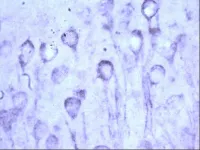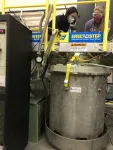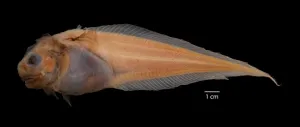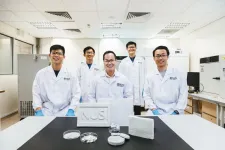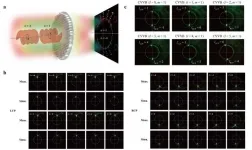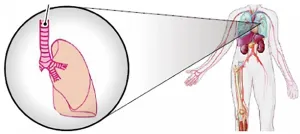(Press-News.org) TAMPA, Fla (April 20, 2021) — Chaperone protein imbalance can play a significant role in initiating toxic accumulation of tau in the aging brain - an early step in the development of Alzheimer's disease and related neurodegenerative disorders known as tauopathies, a new preclinical study by University of South Florida Health (USF Health) neuroscientists suggests.
In humans, misfolding of the protein tau leads to its toxic accumulation inside brain cells, the formation of these tau aggregates into hallmark neurofibrillary tangles, neuron death, and eventually symptoms of cognitive decline such as memory loss and diminished thinking skills.
In this study the USF Health Morsani College of Medicine researchers used mice that were not genetically modified (wild-type mice) to examine the effects of Aha1 and FKBP52, two co-chaperone proteins of heat shock protein Hsp90, in the aging brain. They modeled molecular chaperone imbalance by overexpressing production of Aha1 and FKBP52 in these old, wide-type mice. The findings, highlighted below, were reported April 8 in Acta Neuropathologica Communications.
Hsp90 is a chaperone protein abundant in neurons and other cells in the brain. Normally, co-chaperone proteins assist chaperone proteins in monitoring and sustaining the balance (homeostasis) of proteins critical to cell health.
"The chaperone protein network is your cell's natural defense to maintain homeostasis throughout life, and this study emphasizes the importance of protecting that balance in the aging brain," said principal investigator Laura Blair, PhD, an assistant professor of molecular medicine at the USF Health Byrd Alzheimer's Center, Morsani College of Medicine. "We're excited about using this new model of tauopathy in finding ways to restore chaperone protein balance to delay or stop the progression of Alzheimer's and other neurodegenerative diseases."
Among their many quality-control functions, chaperone protein networks ensure proteins are folded to conform to the proper 3D shapes, transported precisely where needed to do their jobs, and pushed toward degradation if they are abnormally modified or no longer useful. Heat shock proteins like Hsp90, triggered when a cell is under stress, play a particularly important "triage" role in correcting protein misfolding to prevent aggregation.
“But in the aging brain, the balance of the chaperone proteins shifts and creates a system not working as efficiently as it normally would. Large numbers of the chaperone molecules decrease in expression, and a smaller but significant number increase in their expression," Dr. Blair said.
Increasing age is the greatest known risk factor for Alzheimer's disease. So, the USF Health team investigated whether increased levels of FKBP52 and Aha1 alone could initiate pathological features mimicking human Alzheimer's disease in aged wild-type mice - those with no genetic manipulations predisposing their brains to abnormally increase tau aggregation.
Key findings from their new mouse model of tauopathy include:
High levels of FKBP52, and to a lesser extent elevated levels of Aha1, increased tau accumulation over time in the aged, wild-type mice.
The tau accumulation promoted by overexpression of FKBP52, but not Aha1, correlated with increased neuroinflammation through exaggerated activation of neuronal support cells, namely microglia and astrocytes. This was complemented by loss of neurons and cognitive impairments.
Existing mouse models, including those that add or subtract genes, introduce tau mutations, and seed mice brains with human tau, help scientists learn more about the underlying causes of Alzheimer's disease and other tauopathies. However, they tend to be limited in capturing the physiological aspects of neurodegeneration in the context of both normal and abnormal aging.
"We hope this (chaperone imbalance) model will help us better understand the dynamics of tau aggregation and neuroinflammation, including the timing and connections among pathological events, without directly regulating one pathway or the other," Dr. Blair said.
Dr. Blair's team has designed follow-up studies to help unravel if, and when, tau accumulation or neuroinflammation is more influential in causing brain cell toxicity during aging. That could help determine which chaperones — FKBP52, Aha1, or others — may be the best therapeutic target options for restoring protein balance, she said.
Co-lead authors for the USF Health study were postdoctoral fellow Marangelie Criado-Marrero, PhD, and doctoral student Niat Gebru. The research was supported by grants from the National Institutes of Health/National Institute of Neurological Disorders and Stroke and the National Institute of Mental Health.
Chaperone protein imbalance promotes toxic tau buildup in the aging brain
University of South Florida Health study applies a new mouse model of tauopathy, which may help identify therapeutic targets for Alzheimer's and other neurodegenerative diseases
2021-04-20
ELSE PRESS RELEASES FROM THIS DATE:
New pulsed magnet reveals a new state of matter in Kondo insulator
2021-04-20
LOS ALAMOS, N.M., April 19, 2021 -- A recent series of experiments at the National High Magnetic Field Laboratory (National MagLab) at Los Alamos National Laboratory leveraged some of the nation's highest-powered nondestructive magnets to reveal an exotic new phase of matter at high magnetic fields. The experiments studied the unusual Kondo insulator ytterbium dodecaboride (or YbB12) and were the first results from the new 75-tesla duplex magnet housed at the National MagLab's Pulsed Field Facility at Los Alamos.
"This magnet and the resulting experiments are the first fruits of the National Science Foundation-supported pulsed magnet surge," said Michael Rabin, director of the Pulsed Field Facility at Los ...
Water muting with THz optoacoustics: A breakthrough for biomedical applications
2021-04-20
Radiation at terahertz frequencies (wavelengths between 0.03 and 0.3 mm) can be used successfully to analyze the structural dynamics of water and biomolecules. But applying the technique to aqueous solutions and tissues remains challenging, since terahertz (THz) radiation is strongly absorbed by water. While this absorption enables certain analyses, such as the structure of water and its interactions with biological solutes, it limits the thickness of samples that can be analyzed, and it drowns out weaker signals from biomolecules of interest. Strong absorption of THz ...
After 40 years, new fish species in named by students on Guam
2021-04-20
CORVALLIS, Ore. - Four decades after their capture more than a half-mile below the ocean's surface, three snailfish species have received their scientific names, two of them from school children on Guam in the island's native Chamorro language.
The rare specimens of liparids were collected in the early 1980s in traps set in the Mariana Archipelago in the western Pacific Ocean, deposited with NOAA's Pacific Islands Fisheries Science Center in Hawaii and did not get examined until recently, when they were noticed during the center's move to a new location. ...
The perfect fit: A 'shoe-in' for a great start to school
2021-04-20
As the back-to-school rush begins, podiatry experts at the University of South Australia are encouraging parents to get their children's school shoes professionally fitted, as new research confirms that ill-fitted footwear can significantly impede foot movement and comfort.
In a new study, researchers tested the effect of shoe size on foot motion and comfort among children aged 8 to 12 years, finding that shoes that were one size too small restricted the normal movement of the heel, arch and big toe joint during walking.
The study also confirmed that a comfortable shoe fit can be determined by a 'rule of thumb', where the wearer's thumb width from their longest toe to the end of their shoe is an effective and accurate measure ...
Eco-friendly technique by NUS team to upcycle metal waste into multi-purpose aerogels
2021-04-20
Metals are one of the most widely used materials in the world - they are used in cookware, tools, electric appliances, electric wires, computer chips, jewelry and so on. With the growing demand for metal products, it is crucial to promote sustainable and environmentally-friendly methods of recycling metal waste to help reduce the environmental impact of using metals in the economy.
The conventional approaches for recycling metal waste are energy intensive and some of these methods also generate environmentally harmful by-products, such as ammonia and methane during aluminium recycling.
To address this challenge, a team of researchers from the National ...
Single metasurface for simultaneous detection of SAM and OAM
2021-04-20
With inherent orthogonality, both SAMs and OAMs of light have been utilized to expand the dimensions of optical communications and signal processing, wherein unambiguous SAM and OAM identification is one of the significant topics. Conventional sorting approaches suffer from complicated optical setups, multiple bulky devices, repeated projection measurements, and cannot simultaneously distinguish SAM and OAM.
In a new paper published in Light Science & Application, a team of scientists, led by Professor Xiangang Luo from State Key Laboratory of Optical Technologies on Nano-Fabrication and Micro-Engineering, Institute of Optics and Electronics Chinese Academy of Sciences, and co-workers have showed that a single spin-decoupled metasurface that merges the geometric ...
NUS researchers discover protein that causes neurological complications in HFMD
2021-04-20
Hand, Foot & Mouth Disease (HFMD) is a generally mild, contagious viral infection common in young children. In Singapore, HFMD is endemic and is most commonly caused by intestinal viruses known as coxsackieviruses and enteroviruses.
While most HFMD patients experience common symptoms such as sore throat, fever, ulcers inside the mouth and blisters and lesions on the palms and soles, infection with Enterovirus-A71 (EV-A71) may lead to serious neurological complications that can be potentially fatal or lead to long-term neurological deficits (cognitive and motor deficits). These complicated HFMD cases are mainly seen in young children.
Researchers from NUS Yong Loo Lin School of Medicine's Infectious Diseases ...
Surpassing the lower limit on computing energy consumption
2021-04-20
New FLEET research confirms the potential for topological materials to substantially reduce the energy consumed by computing.
The collaboration of FLEET researchers from University of Wollongong, Monash University and UNSW have shown in a theoretical study that using topological insulators rather than conventional semiconductors to make transistors could reduce the gate voltage by half, and the energy used by each transistor by a factor of four.
To accomplish this, they had to find a way to overcome the famous 'Boltzmann's tyranny' that puts a lower limit on transistor switching energy.
They found a surprising result: gate voltage applied to a topological insulator could create a barrier to electron flow larger than the voltage itself times the electron charge, ...
One in five american adults experience chronic pain
2021-04-20
Chronic pain is among the most common chronic conditions in the United States, but estimates of its prevalence and impact vary widely. In 2019, the National Center for Health Statistics of the Centers for Disease Control and Prevention added a new set of questions relating to pain to its National Health Interview Survey (NHIS), a large household-based annual survey that offers valuable insights into the health statuses of U.S. adults nationwide. In an article published in Pain, researchers from Brigham and Women's Hospital and Mass Eye and Ear report that 50.2 million (20.5 percent) ...
Clinical trial assesses stem cells' ability to prevent major cause of preemie deaths
2021-04-20
Durham, NC - A phase 2 clinical trial whose results were released today in STEM CELLS Translational Medicine might point to a way to overcome bronchopulmonary dysplasia (BPD), a major cause of death in preterm infants. The study, conducted by researchers at Samsung Medical Center, Sungkyunkwan University and Asan Medical Center Children's Hospital in Seoul, evaluates the effectiveness of treating these infants by transplanting umbilical cord blood-derived mesenchymal stem cells (UCB-MSCs) directly into their tracheas.
Early results showed signs of improvement for the most immature infants included in the trial.
BPD is a serious breathing disorder in which the lungs do not develop normally. Most infants who develop BPD are born more than ...
LAST 30 PRESS RELEASES:
Synergistic effects of single-crystal HfB2 nanorods: Simultaneous enhancement of mechanical properties and ablation resistance
Mysterious X-ray variability of the strongly magnetized neutron star NGC 7793 P13
The key to increasing patients’ advance care medical planning may be automatic patient outreach
Palaeontology: Ancient tooth suggests ocean predator could hunt in rivers
Polar bears may be adapting to survive warmer climates, says study
Canadian wildfire smoke worsened pediatric asthma in US Northeast: UVM study
New UBCO research challenges traditional teen suicide prevention models
Diversity language in US medical research agency grants declined 25% since 2024
Concern over growing use of AI chatbots to stave off loneliness
Biomedical authors often call a reference “recent” — even when it is decades old, analysis shows
The Lancet: New single dose oral treatment for gonorrhoea effectively combats drug-resistant infections, trial finds
Proton therapy shows survival benefit in Phase III trial for patients with head and neck cancers
Blood test reveals prognosis after cardiac arrest
UBCO study finds microdosing can temporarily improve mood, creativity
An ECOG-ACRIN imaging study solves a long-standing gap in metastatic breast cancer research and care: accurately measuring treatment response in patients with bone metastases
Cleveland Clinic presents final results of phase 1 clinical trial of preventive breast cancer vaccine study
Nationally renowned anesthesiology physician-scientist and clinical operations leader David Mintz, MD, PhD, named Chair of the Department of Anesthesiology at the UM School of Medicine
Clean water access improves child health in Mozambique, study shows
Study implicates enzyme in neurodegenerative conditions
Tufts professor named Fellow of the National Academy of Inventors
Tiny new device could enable giant future quantum computers
Tracing a path through photosynthesis to food security
First patient in Arizona treated with new immune-cell therapy at HonorHealth Research Institute
Studies investigate how AI can aid clinicians in analyzing medical images
Researchers pitch strategies to identify potential fraudulent participants in online qualitative research
Sweeping study shows similar genetic factors underlie multiple psychiatric disorders
How extreme weather events affect agricultural trade between US states
Smallholder farms maintain strong pollinator diversity – even when far from forests
Price of a bot army revealed across hundreds of online platforms worldwide – from TikTok to Amazon
Warblers borrow color-related genes from evolutionary neighbors, study finds
[Press-News.org] Chaperone protein imbalance promotes toxic tau buildup in the aging brainUniversity of South Florida Health study applies a new mouse model of tauopathy, which may help identify therapeutic targets for Alzheimer's and other neurodegenerative diseases
